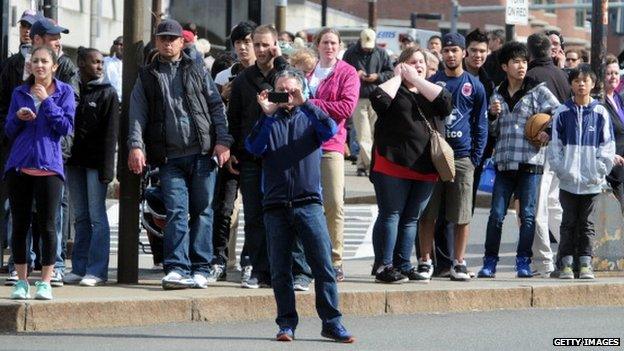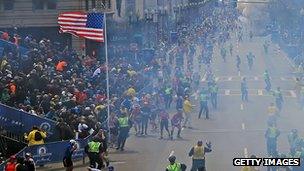The Boston Marathon bomber: Caught on film?
- Published

Many of the spectators at the Boston Marathon had cameras on hand
More personal videos are being shot now than ever before, and such footage could help identify the Boston marathon bomber. But how is that footage processed - and could civilians really solve the crime?
There was the marathon runner closing in on the finish line, and the businessman with offices in a prime position over Boylston Street.
And there were thousands of others crowding the last stretch of the Boston marathon, all capturing the events before and after the bombs exploded.
"The reality is with the number of people who are carrying with them the equivalent of video camera, history is being documented by millions of people every day," says Karen North, director of University of Southern California's Annenberg Program, external on online communities.
Infusing video
In just over a decade, she says, the amount of video being shot by amateurs has increased dramatically - and so too, has the evidence available to law enforcement officials.
"Can you imagine back in JFK's day if you had the proliferation of cameras?" says Grant Fredericks, a forensic video analyst. "There would be no question about the grassy knoll. We'd have answers on day two."
Fredericks manages the National Digital Multimedia Evidence Processing Lab, designed specifically to handle large quantities of video in the wake of a terrorist attack.
The lab's members represent police agencies around the world, any one of which can request assistance in the event of a large-scale incident.
They have consulted with the FBI on the Boston case but are not yet analysing video, which is currently being handled internally by the FBI.
But their work in other cases has set the standard for how crowd footage can be utilised by law enforcement.
Specifically, the lab worked with the Vancouver police to sift through video footage after the Stanley Cup riots in 2011. In doing so, they were able to help bring charges against more than 300 people.
Although the team is made up of police officers, they don't do traditional detective work. Instead, they make it easier for local law enforcement to comb through video to find needed clues, thanks to a painstakingly detailed process.
The first step is combining the various types of footage. Evidence submitted as security feeds and material shot on cameras and phones have different encoding; the lab transcodes all of it into a single file.
Then the real work starts.
"What our team does, and what we do best, is we begin to infuse those images in video with intelligence information - meta data, [global positioning system] info, other location information," says Fredericks.
They encode that data directly into the video, which allows for easy search and analysis.
"Through coding we can establish the kind of hat, shoes, coat, backpack someone is wearing. That becomes a rich database," he says.
Private becomes public
The analysts don't use facial recognition software for large crowd footage. That technology works best with higher resolution images and a known photo, like a passport or driver's licence, with which to compare to the footage.
Nor do they tag and code every person on film. Instead, they direct their search towards those who are most likely to fit a criminal profile.
"They will be making some judgment calls, but they won't be making any investigative calls," Frederick says of his analysts.
"There has to be some kind of profiling: an individual, carrying a heavy package, probably a backpack. Anyone who stands out, anyone who's alone, who looks like they are not part of the game.
"A lot of people will be tagged, and 99% of them will not be the guy."
But Fredericks guarantees that whoever "the guy" or the group of people responsible for the bombing may be, the FBI already has hundreds of images of them.
It's part of the new reality of the digital age.
"If you are running the marathon and you fall down and cry, that private moment can become a public image. That can become part of the history of that event," says North.
"If someone tries to sneak in and do something, that sneaky personal behaviour is much more likely to be captured in the background of someone's private documentation."
The issue of course, is that there is so much private documentation, making the act of finding sneaky behaviour much like finding a digital needle in a haystack.
But Fredericks says more data is always better. "It creates opportunity," he says of the influx of crowd-sourced videos available to investigators

Video forensics can tag persons of interest in chaotic crowd scenes
It also creates conditions for a public manhunt. Sites like Reddit, external and 4chan , externalhave forums devoted to amateur sleuths searching the photos for clues.
In the past, these efforts have sometimes proved successful - several online commentators helped piece together the identity of a Brooklyn purse snatcher based on the surveillance videos, and online groups like Anonymous were able to uncover and expose video evidence in the Steubenville, Ohio rape case.
Assessing validity
"The more people you have generating ideas and collecting data, the better," says Paul Hines, external, assistant professor in the school of engineering at the University of Vermont.
He says that big groups can bring fresh perspective, and a big enough group even fights against mob mentality and group think, because people want to distinguish themselves from the crowd by presenting new ideas.
"It doesn't mean everything you get will be valid," he warns. "You still need a mechanism to assess the ideas' validity."
Frederick can attest to that. He says many of the amateur guesses he's seen have not been credible - for instance, the many people online who pointed with suspicion to two men in bulky backpacks, communicating through earpieces.
"They were police officers," he says.
He warns that profiling without law enforcement training can lead to panic and damaging false accusations - and points out that the FBI and other law enforcement teams do a good job, very quickly.
But ordinary people's footage can offer vital help in that complex process.
- Published16 June 2011
- Published13 March 2013